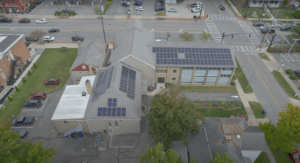St. Mark’s Goes Solar; Federal Solar Tax Incentives for Non-Profits
YouTube: https://youtu.be/G6F40C0LMCE
St. Mark’s Lutheran Church in Delaware has taken a big step toward a renewable energy future! Last month we completed their installation of 112 solar panels, thanks in part to the Inflation Reduction Act of 2022. In addition to extending the solar tax credit, the bill expanded the credit to give municipalities and non-profit organizations more incentives to go green.
When Dr. Louis Iverson, the Solar Project Chair for St. Mark’s and a retired ecologist for the US Forest Service, heard about this, he knew it was time. “In the past couple of decades there has been a tremendous decrease in the price of solar, so it’s an ideal time […] with the passage of the Inflation Reduction Act of 2022, suddenly we get a 30% payback from the IRS once our job is completed.” Members of the congregation were also excited to team up and donate to cover the costs of some of the solar panels. “We also generated a lot of money for this project by offering the congregation a chance to donate a panel – in memory of someone or in honor of someone {…] we were able to generate 36 out of the 112 panels in this way.”
Going green may be a practical choice, but for the congregation at St. Mark’s, it’s also a matter of principle. “As a church, we’re to take care of God’s creation, and this is an ideal way to do that,” Iverson said. “We might be able to set a precedent here for other churches as well to use this as a very economical and ecological way to help.” Indeed, over the past couple of decades, people of many religious faiths have felt a responsibility to take care of our environment. The IRA is the first piece of legislation that has recognized and incentivized faith-based organizations to take action.
What’s the difference between this and the residential/commercial clean energy credit?
Although the IRS has not yet released the tax forms for non-profits, information about the Elective Pay option is available on their website. Tax-exempt organizations, including (but not limited to) churches and religious groups, charities, labor organizations, states, local governments, and Indian tribal governments are all eligible for the elective pay option. These organizations must own the property upon which the qualifying clean energy project is installed. Once their taxes are filed, they will receive a tax return equal to 30% of the total cost of the project. Note: some organizations that are not normally required to file tax returns will need to file a return on time in order to be eligible.
Residential and commercial property owners are not eligible for the tax return. Instead, 30% of the total cost of installation will be applied as a tax credit. The total cost of the system will be deducted from the amount of tax the owner of an installed system owes in taxes – this means your tax bill can be completely erased. If 30% of the cost exceeds what you owe in taxes, the credit will roll over in subsequent years.
However, both the elective pay and tax credit options require that the individual or organization filing own the system outright. Systems must be installed and commissioned before the end of the calendar year for which taxes are being filed. Leased and transferred systems or credits are not eligible for any of the tax credits – however, if you purchase a property with a system installed in 2022 or later AND the original owner did not apply for a tax credit on that system, you may ask the builder for a reasonable allocation to determine how much of the cost of the property is eligible for a credit. Additional costs, such as financing interest, extended warranty costs, and origination fees are not applicable.
Have you filed for a clean energy tax credit? If so, we’d love to hear from you! Please contact us at [email protected] to share your experience.







